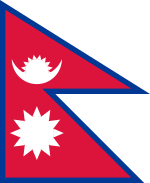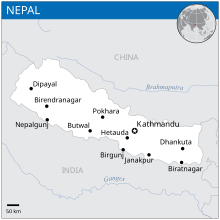Nepalis
नेपाली नागरिक Nepalese Citizens | |
|---|---|
 Flag of Nepal | |
| Total population | |
c. 30 million[1] | |
| Regions with significant populations | |
| 2,926,168[3] | |
| 300,000[4] | |
| 265,000[5] | |
| 59,490[6] | |
| 17,140[7] | |
| 15,950[8] | |
| 3,632[9] | |
| 3,500[10] | |
| 2,199[11] | |
| Languages | |
Nepali • Maithili • Bhojpuri • Awadhi • Tharu • Tamang • Newari • Bajjika • Magar • Dotyali • Urdu and 113 others[12] | |
| Religion | |
and others 0.9%.[13] | |
a Total population of Nepal, b Nepali-speaking population, c Nepali diaspora | |
The Nepalis (English: Nepalese ; Nepali: नेपाली) are citizens of the Federal Democratic Republic of Nepal under the provisions of Nepali nationality law.[14][15] The country is home to people of many different national and ethnic origins. As a result, people of Nepal do not equate their nationality with ethnicity, but with citizenship and allegiance. Although citizens make up the majority of Nepali, non-citizen residents, dual citizen, and expatriates may also claim a Nepali identity.
Nepal is a multicultural and multiethnic country. Nepali are multilinguistic group that speak 123 languages as recorded in 2011 Nepal census.[12]Kathmandu Valley, in the middle hill region, constitutes a small fraction of the nation's area but is the most densely populated, with almost 5 percent of the nation's population.[2][16]
Contents
1 Etymology
2 Nepali nationality
3 Nepali caste/ethnic groups
4 Gallery
5 See also
6 References
6.1 Footnotes
6.2 Notes
Etymology

People having citizenship and allegiance of Nepal are Nepali
Local legends say that a Hindu sage named "Ne" established himself in the valley of Kathmandu in prehistoric times and that the word "Nepal" came into existence as the place was protected ("pala" in Pali) by the sage "Ne". It is mentioned in Vedic texts that this region was called Nepal centuries ago. According to the Skanda Purana, a rishi called "Ne" or "Nemuni" used to live in the Himalayas.[17] In the Pashupati Purana, he is mentioned as a saint and a protector.[18] He is said to have practised meditation at the Bagmati and Kesavati rivers[19] and to have taught there.[20]
The name of the country is also identical in origin to the name of the Newar people. The terms "Nepāl", "Newār", "Newāl" and "Nepār" are phonetically different forms of the same word, and instances of the various forms appear in texts in different times in history. Nepal is the learned Sanskrit form and Newar is the colloquial Prakrit form.[21] A Sanskrit inscription dated 512 CE found in Tistung, a valley to the west of Kathmandu, contains the phrase "greetings to the Nepals" indicating that the term "Nepal" was used to refer to both the country and the people.[22][23]
Nepali nationality
The founder of modern Nepal, Badamaharajadhiraja (meaning: Great of the great sovereign kings) Prithvi Narayan Shah[24] is considered a unifying figure and symbol of Nepali National Unity.[25] He is considered a visionary leader and his birthday is celebrated as National Unity Day after years of Maoist hegemony and demolition of monarchial history called as Krambhanga (Paradigm Shift).[26][24]
Nepali caste/ethnic groups
The population ranking of 125 Nepali castes/ethnic groups as per the 2011 Nepal census.[27][note 1]
| Rank | Caste/ethnic groups | Population | Percentage composition |
|---|---|---|---|
| 1 | Chhetri | 4,398,053 | 16.60% |
| 2 | Hill Brahman/Bahun | 3,226,903 | 12.18% |
| 3 | Magar | 1,887,733 | 7.12% |
| 4 | Tharu | 1,737,470 | 6.56% |
| 5 | Tamang | 1,539,830 | 5.81% |
| 6 | Newar | 1,321,933 | 4.99% |
| 7 | Kami | 1,258,554 | 4.75% |
| 8 | Musalman (taken as a single ethnic group) | 1,164,255 | 4.39% |
| 9 | Yadav | 1,054,458 | 3.98% |
| 10 | Rai | 620,004 | 2.34% |
| 11 | Gurung | 522,641 | 1.97% |
| 12 | Damai/Dholi | 472,862 | 1.78% |
| 13 | Thakuri | 425,623 | 1.61% |
| 14 | Limbu | 387,300 | 1.46% |
| 15 | Sarki | 374,816 | 1.41% |
| 16 | Teli | 369,688 | 1.40% |
| 17 | Chamar/Harijan/Ram | 335,893 | 1.27% |
| 18 | Koiri/Kushwaha | 306,393 | 1.16% |
| 19 | Musahar | 234,490 | 0.89% |
| 20 | Kurmi | 231,129 | 0.87% |
| 21 | Sanyasi/Dasnami | 227,822 | 0.86% |
| 22 | Dhanuk | 219,808 | 0.83% |
| 23 | Dusadh/Pasawan/Pasi | 208,910 | 0.79% |
| 123 | Raute | 618 | 0.00% |
| 124 | Nurang | 278 | 0.00% |
| 125 | Kusunda | 273 | 0.00% |
| - | Others undefined and foreigners | 282,321 | 1.07% |
| - | Total | 26,494,504 | 100.00% |
Gallery

Gautam Buddha

Prithvi Narayan Shah

Tenzing Norgay Sherpa

Bhanubhakta Acharya

Amar Singh Thapa
Udit Narayan

Manisha Koirala

Rajesh Hamal

Anmol K.C.

Samragyee R.L. Shah

Limbu Male and Female of Nepal
See also
- List of Nepali people
- Culture of Nepal
- Demographics of Nepal
- Religion in Nepal
- Ethnic groups in Nepal
- Kazara
- Languages of Nepal
- Gurkha
- Music of Nepal
References
Footnotes
^ Pages 191/192 of the total pdf or pages 156/157 in the scanned material shows Nepali castes/ethnic groups
Notes
^ Total population: 30 million. Population of Nepal: 26,494,504 (2011), number of Nepali speakers in India: 2,871,749 (2011), number of Nepali speakers in Bhutan: 265,000.
^ ab "Decadal Growth :www.cbs.gov.np" (PDF). Archived from the original (PDF) on 2013-07-31..mw-parser-output cite.citation{font-style:inherit}.mw-parser-output q{quotes:"""""""'""'"}.mw-parser-output code.cs1-code{color:inherit;background:inherit;border:inherit;padding:inherit}.mw-parser-output .cs1-lock-free a{background:url("//upload.wikimedia.org/wikipedia/commons/thumb/6/65/Lock-green.svg/9px-Lock-green.svg.png")no-repeat;background-position:right .1em center}.mw-parser-output .cs1-lock-limited a,.mw-parser-output .cs1-lock-registration a{background:url("//upload.wikimedia.org/wikipedia/commons/thumb/d/d6/Lock-gray-alt-2.svg/9px-Lock-gray-alt-2.svg.png")no-repeat;background-position:right .1em center}.mw-parser-output .cs1-lock-subscription a{background:url("//upload.wikimedia.org/wikipedia/commons/thumb/a/aa/Lock-red-alt-2.svg/9px-Lock-red-alt-2.svg.png")no-repeat;background-position:right .1em center}.mw-parser-output .cs1-subscription,.mw-parser-output .cs1-registration{color:#555}.mw-parser-output .cs1-subscription span,.mw-parser-output .cs1-registration span{border-bottom:1px dotted;cursor:help}.mw-parser-output .cs1-hidden-error{display:none;font-size:100%}.mw-parser-output .cs1-visible-error{font-size:100%}.mw-parser-output .cs1-subscription,.mw-parser-output .cs1-registration,.mw-parser-output .cs1-format{font-size:95%}.mw-parser-output .cs1-kern-left,.mw-parser-output .cs1-kern-wl-left{padding-left:0.2em}.mw-parser-output .cs1-kern-right,.mw-parser-output .cs1-kern-wl-right{padding-right:0.2em}
^ "Scheduled Languages in descending order of speaker's strength - 2011" (PDF). Registrar General and Census Commissioner of India.
^ The Irrawaddy - LAWI WENG. "The Forgotten Gurkhas of Burma". The Irrawaddy. Retrieved 20 May 2014.
^ http://archive.ethnologue.com/16/show_language.asp?code=nep
^ "ASIAN ALONE OR IN COMBINATION WITH ONE OR MORE OTHER RACES, AND WITH ONE OR MORE ASIAN CATEGORIES FOR SELECTED GROUPS". United States Census Bureau. United States Department of Commerce. 2010. Retrieved 13 September 2016.
^ Statistics Canada. "Census Profile, 2016 Census". Retrieved 25 March 2018.
^ "Thematic Report: Ethnic Minorities" (PDF). Publications and Products of the 2006 Population By-census. Census and Statistics Department, Hong Kong (xvi). 2007-12-28. Retrieved 2008-01-23.
^ "Väestö 31.12. muuttujina Alue, Taustamaa, Sukupuoli, Vuosi ja Tiedot". Tilastokeskuksen PX-Web tietokannat.
^ "Start Kathmandu-Guangzhou flight: NRNs". The Himalayan Times. Archived from the original on 12 January 2006. Retrieved 13 September 2016.
^ "CBS StatLine - Bevolking; generatie, geslacht, leeftijd en herkomstgroepering, 1 januari". Statline.cbs.nl. Retrieved 5 October 2017.
^ ab Official Summary of Census (2011), Central Bureau of Statistics, Nepal Archived 2012-12-02 at the Wayback Machine.
^ Statistical Yearbook of Nepal - 2013. Kathmandu: Central Bureau of Statistics. 2013. p. 23. Retrieved 13 December 2015.
^ http://www.lawcommission.gov.np/en/documents/2015/08/nepal-citizenship-rules-2063-2006.pdf Nepal Citizenship Act 2006
^ http://www.legalnepal.com/Nepal_citizenship_act.pdf Nepal Citizenship Act 2006(in Nepali)
^ "Nepali peoples and nationality law". The World Factbook. CIA.
^ Dangol, Amrit (6 May 2007). "Alone in Kathmandu". Alone in Kathmandu. Retrieved 29 July 2009.
^ Prasad, P. 4 The life and times of Maharaja Juddha Shumsher Jung Bahadur Rana of Nepal
^ Khatri, P. 16 The Postage Stamps of Nepal
^ W.B., P. 34 Land of the Gurkhas
^ Malla, Kamal P. "Nepala: Archaeology of the Word" (PDF). Archived from the original on 22 March 2012. Retrieved 5 May 2011. Page 7.
^ Malla, Kamal P. "Nepala: Archaeology of the Word" (PDF). Archived from the original on 22 March 2012. Retrieved 5 May 2011. Page 1.
^ Majupuria, Trilok Chandra; Majupuria, Indra (1979). Glimpses of Nepal. Maha Devi. p. 8. Retrieved 2 December 2013.
^ ab Rai, Om Astha. "Back To Unity". The Nepali Times. Retrieved 12 January 2018.
^ Simkhada, Dhruba. "Nepal founder's legacy". The Nepali Times. Retrieved 12 January 2018.
^ Kharel, Shekhar. "Prithvi Narayan Shah reborn". The Nepali Times. Retrieved 12 January 2018.
^ "Nepal Census 2011" (PDF).









